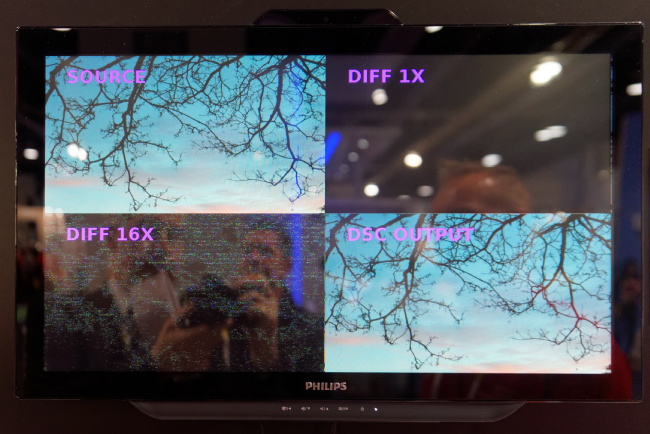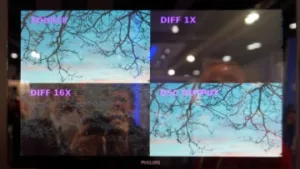The first meeting we had on the show floor was with VESA, which was highlighting DisplayPort. The big development over the last year has been the introduction of USB Type C interfaces that include the DisplayPort “Alt” mode. There were a number of products announced early (especially the MacBook and the Google Chromebook) and now there are expected to be a number of new products, with Dell announcing the XPS 13 late in 2015, with support for Thunderbolt 3 (which includes DP).
Another new product was the ASUC MB1696+ monitor, which is a “USB monitor” that uses a Type C cable to connect to get power as well as using the DisplayPort connection for graphics.
On the booth, we got the first of a number of demonstrations of a Microsoft Lumia Phone that uses its Type C port to connect to a DisplayPort monitor, which invokes a special mode (Continuum) in Windows 10 under which the phone can use the monitor as a display, while the phone uses its display as a touch surface. It was impressive and a clear indicator of future possibilities.
Type C offers faster charging than USB because of the Power Delivery options. The interface also allows support of the Adaptive Sync that is becoming more interesting for gamers.
Hardent was on the booth to promote the DisplayStream Compression (DSC) standard which is included in DisplayPort V1.4 (not yet announced). There is a new version of DSC, 1.2 which has more bit depth and with the option of 4:2:0 support for video applications. Hardent told us that there is an error level on DisplayPort (and HDMI) of around 1 in 10-9. This is not normally visible, but combined with DSC it can become visible, so at 60Hz in 8K there is no problem, but at 120Hz in 8K, 4:2:0 becomes useful.
 Hardent showed this demo of DSC that shows a 16X version of the changes made in the bottom left corner.
Hardent showed this demo of DSC that shows a 16X version of the changes made in the bottom left corner.
There is still work going on in VESA to support a 4:1 version of DSC (Advanced DSC) as the current versions support 2:1 compression.
In the mobile space, there was a demo of Panel Self Refresh, where the TCon of the display can include a frame buffer. With embedded DisplayPort (eDP) V1.4, there is an option to only send the changed (delta) pixels from the system to the display. That can mean that the CPU can save a lot of power if not much is happening on the display. Although a frame buffer might add only 50¢ to the BOM cost, but that can be a barrier to use. In higher end mobile devices, the advantages of better power consumption and slightly reduced weighting can offset the cost disadvantage. VESA expects eDP V1.4b to be in products by mid-2016.
VESA has been working on the integration of DisplayPort with the WiGig wireless in 802.11ad and Parade was testing the technology.
Analyst Comment
VESA is doing well with the Type C “Alt” mode. Although there is an “Alt” mode for MHL, I have yet to find anybody that is planning to use it in a device (although LG was added to the list of TV companies adding MHL to their TVs).
We heard that HDMI may want to introduce an “Alt” mode for HDMI. It seems to us that if this had happened when VESA announced its version in mid-2014, but, by now, the effect of the group adding a mode is just likely to add confusion by only being adopted by a few vendors, but also sowing confusion among consumers. However, the idea of the “Alt” mode is to allow customisation, so there is little that the USB-IF can do to stop this happening, even if it wanted to. (BR)

